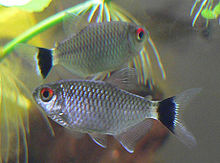The redeye tetra (Moenkhausia sanctaefilomenae), is a species of tetra from the São Francisco, upper Paraná, Paraguay and Uruguay river basins in eastern and central South America.[2][3] This freshwater fish is commonly kept in aquariums and bred in large numbers at commercial facilities in Eastern Europe and Asia.[4] The redeye tetra is one of the more popular aquarium fish due to their schooling capability.
| Redeye tetra | |
|---|---|

| |
| Moenkhausia sanctaefilomenae | |
| Scientific classification | |
| Domain: | Eukaryota |
| Kingdom: | Animalia |
| Phylum: | Chordata |
| Class: | Actinopterygii |
| Order: | Characiformes |
| Family: | Characidae |
| Genus: | Moenkhausia |
| Species: | M. sanctaefilomenae
|
| Binomial name | |
| Moenkhausia sanctaefilomenae (Steindachner, 1907)
| |
It can grow up to 7 cm (2.8 in) in length,[4] and live for approximately 5 years.[3] The red-eye tetra has a bright silver body accented by a white-edged black basal half of the tail and a thin red circle around its eye. It is part of a group that consists of three similar species, the two others being M. forestii (upper Paraguay and upper Paraná basins) and M. oligolepis (Amazon and Paraguay basins, and the Guianas).[5]
Yellow-banded tetra is another common name for the M. sanctaefilomenae. The fish has a yellow band on its caudal peduncle, which differentiates it from the glass tetra.[6]
In the aquarium
editThis section needs additional citations for verification. (April 2023) |
Because of the redeye tetra's hardiness and ease of care, it is considered by aquarists to be an excellent beginner fish. It is readily available, peaceful, and is suitable for most community aquariums,[4] although it is quite active and may disturb slower, more timid species.
The redeye tetra is a schooling fish.[6] For this reason aquarists often keep it in groups of six or more.[2] Although generally peaceful, some redeye tetras have been known to be fin nippers on rare occasions, even when kept in groups. If kept alone it is more likely to nip the fins of other fish.[7] A fish tank with volume of about 110 litres (29 US G.) is commonly used.
The species is frequently kept at temperatures of 23–28 °C (73–82 °F) in hard water (100–150 mg/L) with neutral pH (7.0), in a tank with plants around the sides and to the rear and a clear area in the front.[6] Redeyes are reported to be adaptable to a range of water conditions.[6]
Nutrition
editIn the wild the redeye tetra feeds on worms, insects, crustaceans and plant matter.[2] In the aquarium, redeye tetras generally eat all kinds of live, fresh, and flake foods. It can be fed both prepared foods and live foods in captivity.[6]
Breeding
editFemales are larger and have a more rounded abdomen than the males.[4] When attempting to breed them, a separate breeding tank with slightly acidic, very soft water (4 dGH or below) is often used,[4] with the tank densely planted.[6] The redeye tetra is free spawning, but will also lay eggs among the roots of floating plants.[4]
Once spawning has occurred, the mating pair are typically removed, as they will consume the eggs and hatchling fry.[4] The eggs typically hatch one day after they are laid. Aquarists initially feed the fry with infusoria, rotifers, or commercially prepared fry foods, then freshly hatched brine shrimp, and eventually finely crushed flake foods.[4]
References
edit- ^ "Moenkhausia sanctaefilomenae". IUCN Red List of Threatened Species.
- ^ a b c Froese, Rainer; Pauly, Daniel (eds.). "Moenkhausia sanctaefilomenae". FishBase. April 2008 version.
- ^ a b "Red Eye Tetra". about.com. Retrieved 2008-05-01.
- ^ a b c d e f g h Riehl & Baensch (1987). "Aquarium Atlas Volume 1", Mergus, p.302
- ^ Benine, R.C.; T.C. Mariguela; C. Oliveira (2009). "New species of Moenkhausia Eigenmann, 1903 (Characiformes: Characidae) with comments on the Moenkhausia oligolepis species complex". Neotropical Ichthyology. 7 (2): 161–168. doi:10.1590/S1679-62252009000200005. hdl:11449/18468.
- ^ a b c d e f Alderton, David (2019). Encyclopedia of Aquarium and Pond Fish (3rd ed.). UK: Dorling Kindersley Limited. p. 101. ISBN 978-0-2413-6424-6.
- ^ "Red-Eye Tetra - Moenkhausia sanctaefilomenae". fishlore.com. Retrieved 2008-05-01.
